The Best Beginner’s Guide To Flower Gardening
Welcome to the ultimate beginner’s guide to flower gardening- we walk you through everything you need to know to grow beautiful flowers… no experience needed.
Thumbing through modern day garden magazines may find you in awe of the magnificent, sprawling flower gardens that seem to flow effortlessly from a packet of seeds.
We all know the reality is flower gardening doesn’t always turn out the way we would hope, and building a new flower garden can be intimidating!
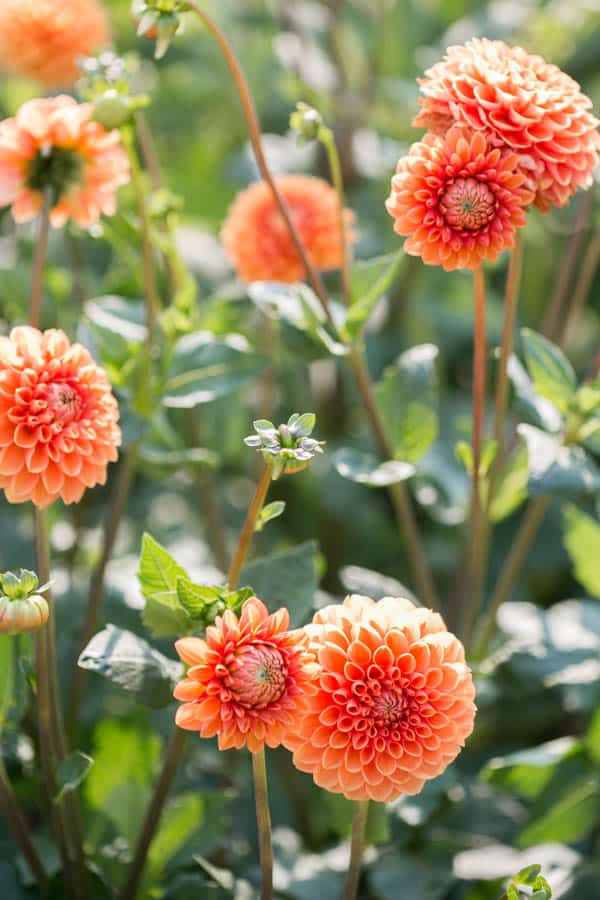
But fear not, because we are here to take the challenge out of flower gardening for the beginner gardener and give you the gift of green thumbs.
We are sharing all the tips a beginner gardener needs to know to get started with their new flower garden, successfully. You can leave the Martha Stewart magazine at the check out aisle!
Read the surprising benefits of flower gardening here.
Understand Your Growing Zone
The most crucial part of creating a flower bed bursting with beautiful flowers is to understand your growing zone and your micro climate.
Let’s jump into what both of these terms mean so we have a solid grasp of how climate and location affects flower gardening!
Growing Zones
Growing zones refer to the specific geographical area in which you live and what can grow in this area.
The United States is divided up into different growing zone sections based on the average winter temperatures. These winter temperatures dictate which plants can survive over winter and which ones can’t. This is often referred to as plant hardiness.
Each zone is about ten degrees warmer or colder than the zone next to it.
Think about your growing zone as simply a guide for what plants will thrive in your specific corner of the world. If you live in a desert in Arizona, for example, the plants that will grow and thrive will be very different than if you lived in rainy and moderate Oregon.
Some flowers will grow year after year in warmer areas, but in colder areas those same plants will die back in the fall.
Your specific zone information will identify the plants that will survive in the winter where you live.
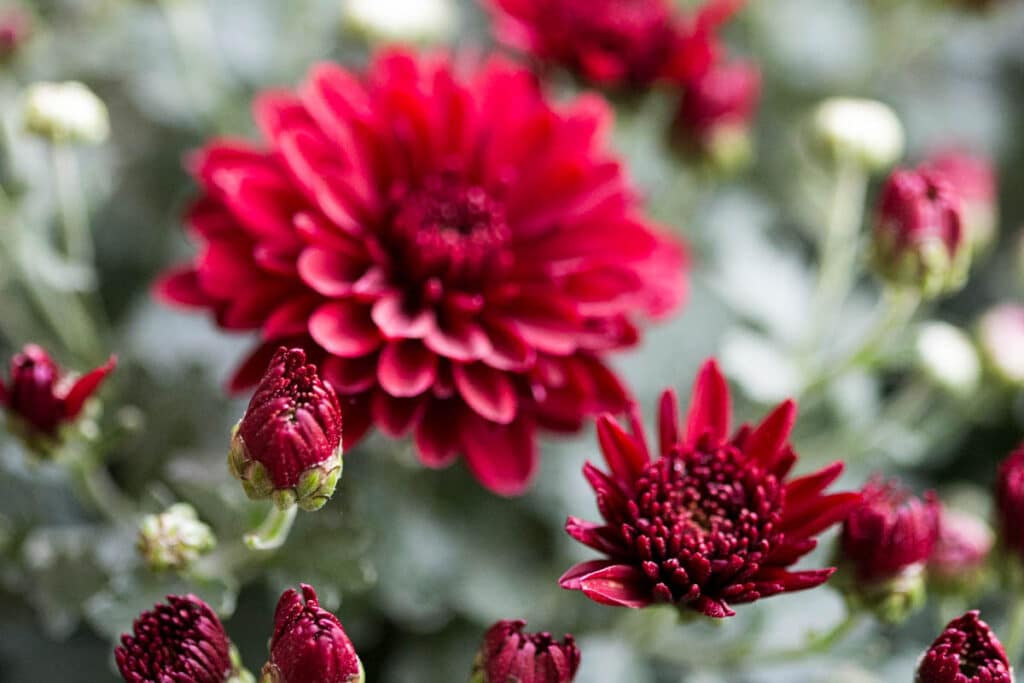
Be inspired with this beautiful tour of the Portland Rose Garden here!
Micro Climates
Micro Climate: Did you know you have a unique climate of your very own that will affect how new plants thrive in your garden?
Your micro climate describes how your specific weather patterns and temperatures will affect the growth of your plants. If you live in a valley location full of sun you will be able to grow different flowers than a home high on a hillside with lots of evergreen trees about.
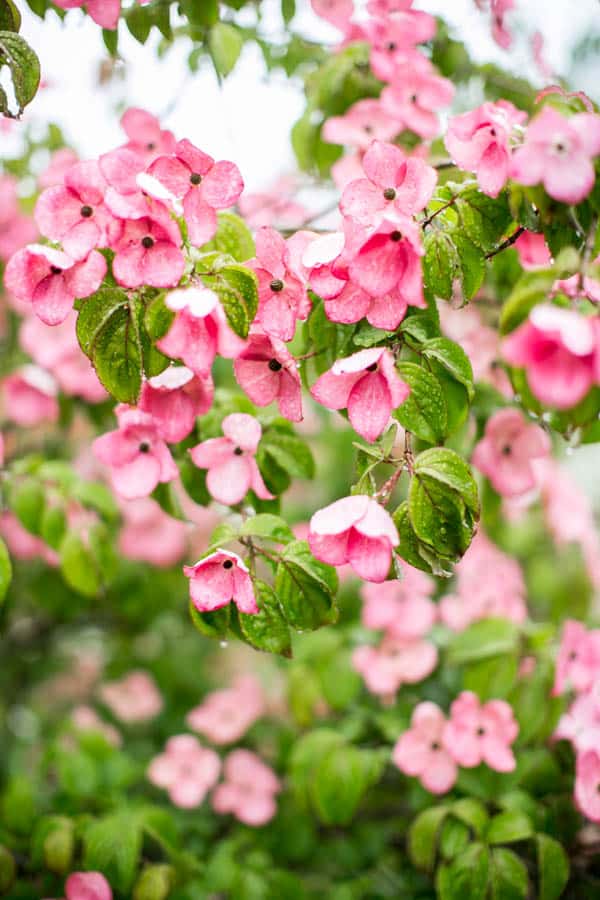
Your micro climate is simply the heat, wind, light and temperatures local to your exact area.
Different types of plants will grow well in different micro climates!
The fun part of growing flowering plants is that YOU, the flower gardener, get to become the expert on your own micro climate and home garden area. Your job is to watch the light, inspect the soil, and understand the weather around your own home.
We give you plenty of tools to do just that in this post!
Having a basic understanding of your growing zone and micro climate will help you choose the right flowers to create your dream garden. Keep a gardening journal and jot down the changes in light and weather around your home.
Different Types Of Flowering Plants
When designing a flower garden, it is a good idea to be aware of the many different types of flowers and flowering trees and shrubs that are available.
While the sheer volume of flowering plants can be overwhelming, we’ve broken in down into a few categories that will make it easier to understand when building a new garden.
Perennial flowers, annual flowers, flowering trees and shrubs, and flowering herbs are all excellent additions to the flower garden:
Annual Flowers
Annual flowers spend one season growing into a plant, establishing flower buds, and blooming.
When winter frosts hit they die, and they do not come back the next year. Some common annual flowers are cosmos, zinnias, impatiens, and petunias and sunflowers.
Annuals are often grown from seed or purchased as small plants from a garden center.
The benefit of using annuals is that they add bright colors for the summer growing season with plants that normally do not thrive in that specific zone, but can be grown in the heat of summer. Since the flowers die in late fall, you can experiment with different varieties of flowers year after year.
The downside of annual flowers, of course, is that you have to invest in them each year, and they need to be re planted (which some of us really, really enjoy!).
(Keep in mind that in warm areas, some annual flowers can be grown as perennials!).
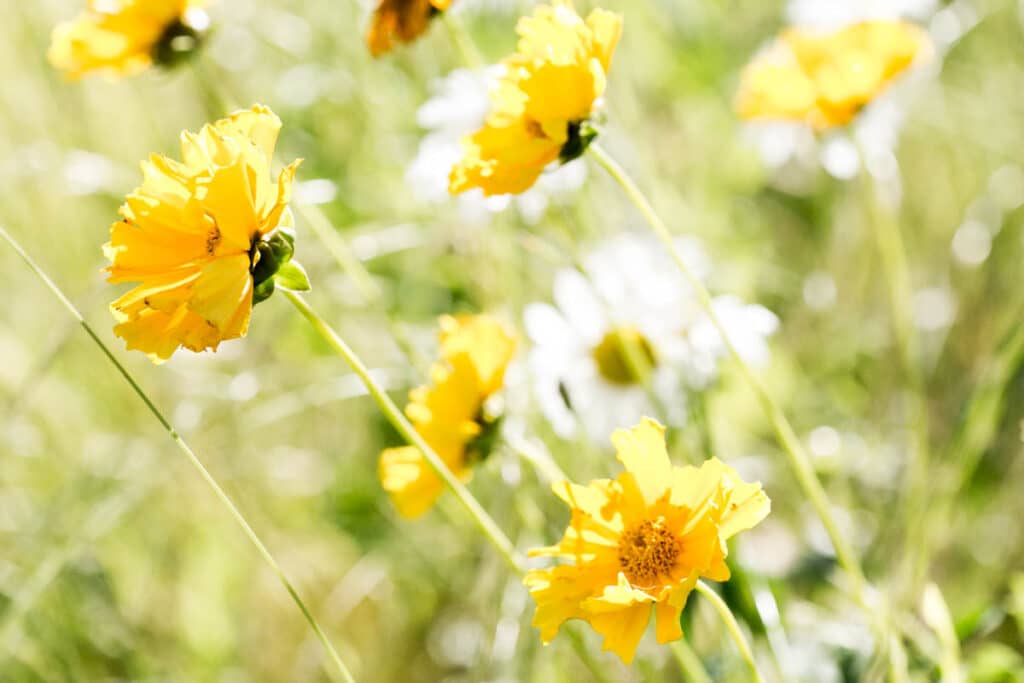
Perennial Flowers
Herbaceous perennials are flowering plants that die back to the ground when frost hits, but their roots remain alive and the plant sprouts from the soil again the following year!
Perennials give you the backbone for an amazing flower garden, bringing blooms that will grace your floral garden year after year.
Some of the best plants that are flowering perennials: peonies, dahlias, echinacea, roses, shasta daisies, and lupine. (Read our list of early spring perennials here!).
The benefits of perennial flowers are that they provide flowers year after year. You do not need to re buy the plant each year OR re design your flower bed.
And many herbaceous perennials will produce bigger, healthier blooms as they grow (like our beloved pink peonies). (Get our guide to the best perennial flowers for arrangements here).
The downside of flowering perennials is that they often require some upkeep. You may need to provide mulch (a warm cover for flower roots in winter), cut them back each fall, and divide their roots or tubers.
Both perennial and annual flowers can be excellent choices for a cut flower garden. Most flower gardens have a mixture of both.
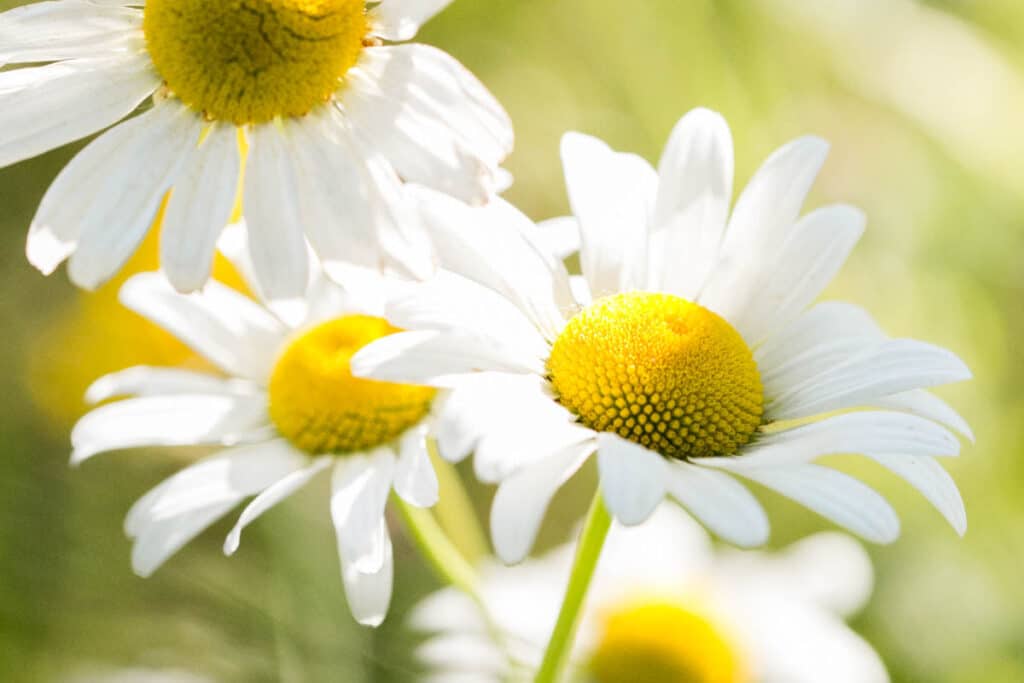
Flowering Trees and Shrubs
Flowering trees and shrubs are another option to add to your flower beds. They add dimension by adding height and contrast to the garden, and many boast beautiful blooms.
Lilacs, hydrangea, camellia, and rose bushes are some examples of flowering shrubs.
When planning and designing a flower garden, you can choose a couple of larger flowering shrubs or trees as pillars in your garden design.
These shrubs will provide extra blooms throughout the seasons and add interest and character to the garden. They also provide shade for those flowers you may fall in love with that need protection from harsh afternoon sunlight.
Get inspiration for a cottage style garden here.
While adding trees and shrubs can be intimidating, it doesn’t have to be. The key is to start slow and understand the plants you are working with. Make your planting choices knowing that these trees and shrubs will mature, adding shade to the garden beds.
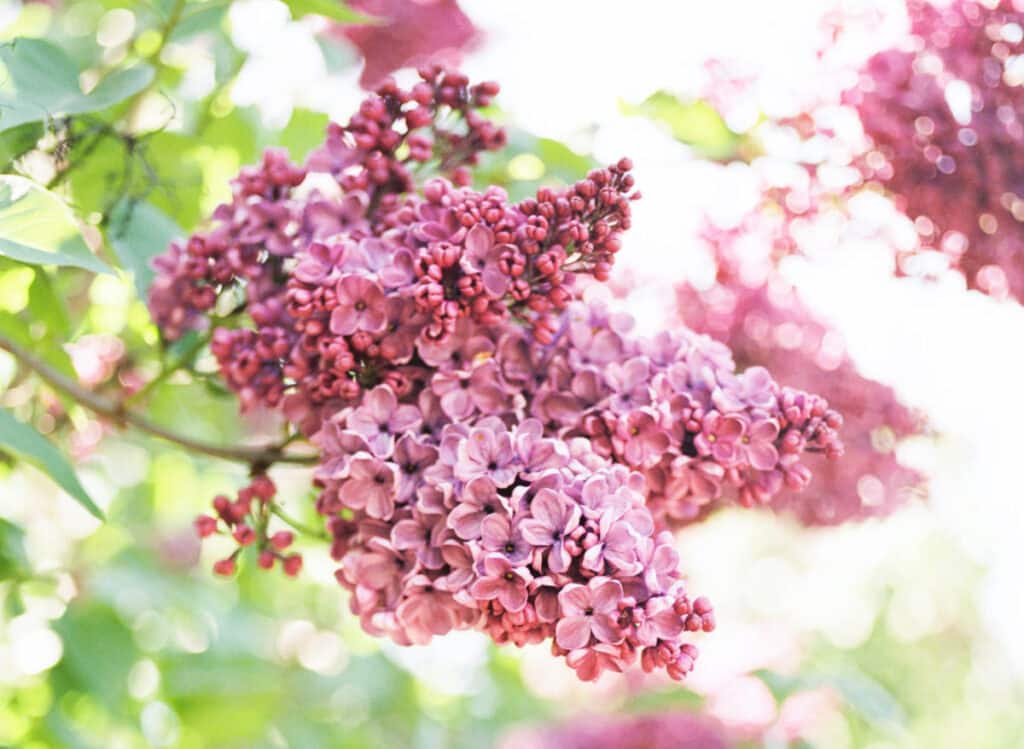
Herbs
Lastly, we’d love to mention flowering herbs as a wonderful addition to the flower beds. We have been absolutely delighted over the years with the beauty of flowering sage, lavender and even mint.
Some herbs can easily be planted alongside flowers without spreading and over taking the flower bed. And some you’ll want to keep out of the flower garden design because they spread prolifically.
We recommend lavender, cat mint and sage because they bloom beautifully and don’t spread. Add mint in containers, they will also bloom beautifully.
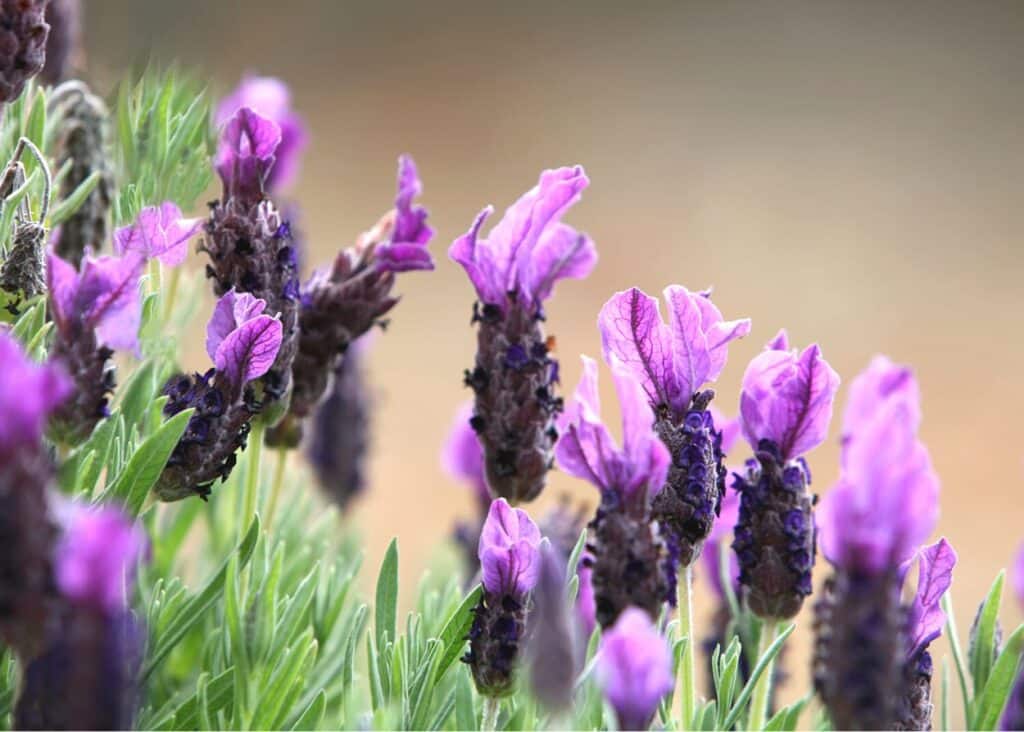
Flowering trees, shrubs and herbs can add interest and variety to a flower garden. Slowly research different plants and add them to your garden as time and budget allow.
Use a gardening journal to make note of flowers you especially love!
When beginning your flower gardening journey, it can be very helpful to pick just a few plants you love and focus learning as much as you can about growing those plants successfully.
Caring For Flowers
We are now going to dive into the details of your flower’s basic needs: sunlight, soil, and water, and dead heading (pruning).
Sunlight
The Basics: Plants need light to flower, but each individual plant has a different requirement for light! Use your notes on your micro climate as your guide for what plants will grow well in your own flower garden.
Sunlight is a crucial part of growing flowers. Many plants require full sun to produce flower blooms, and problems can stem from lack of sunlight.

When you purchase a new plant there is usually an informational plant tag that will indicate what kind of light conditions a plant needs in order to thrive.
The amount of sunlight will differ from plant to plant, and some varieties within the same species will even tolerate different light conditions!
The light conditions will dictate what you can grow in your flower beds.
Understanding the light is a key part to understanding your micro climate. Studying the light conditions as they change from season to season is essential for understanding what you can and cannot grow.
Become a student of your specific garden area. You’ll be surprised at how much you enjoy learning about the natural light around your home, and how much it teaches you about the plants that can grow there!
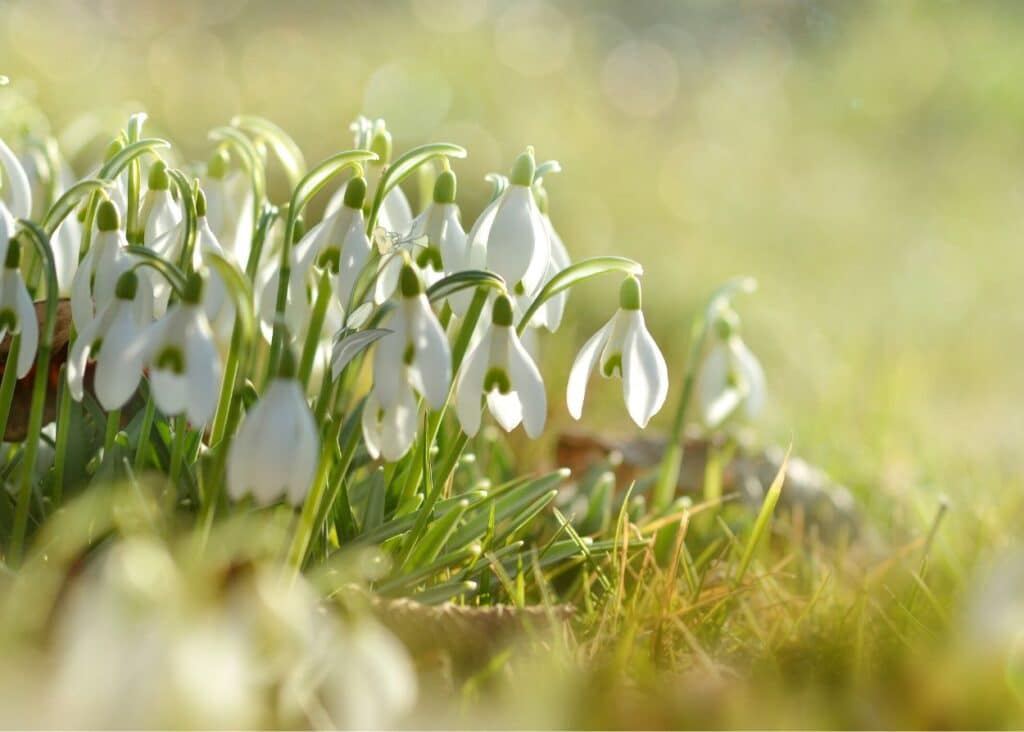
Here is a list of definitions for common light situation:
Full Sun: Full sun is 6 hours of sunlight, or more, per day. As you grow in your knowledge of flowers, you will find that some plants thrive with 6 hours of morning sun and then afternoon shade. And some flowers really need a full day of sun, which can be 8 hours or more (sunflowers and cosmos are two examples).
Part Sun: Part sun is 4 to 6 hours of sunlight per day. These plants can tolerate some shade, especially in the intense hours of afternoon heat, and still grow and bloom beautifully.
Part Shade: Part shade plants need afternoon shade! These plants do not enjoy intense afternoon sunlight, and need to be protected during the hottest parts of the day. Hydrangeas are a good example of a flowering shrub that do best with morning light and afternoon shade.
Shade: Shade plants do not tolerate intense sunlight well and typically need 4 hours or less of sun per day. Areas of dappled light often work well for these flowers. Begonias, bleeding heart, camellia and dogwood trees are a few examples of flowering plants that do well in shade.
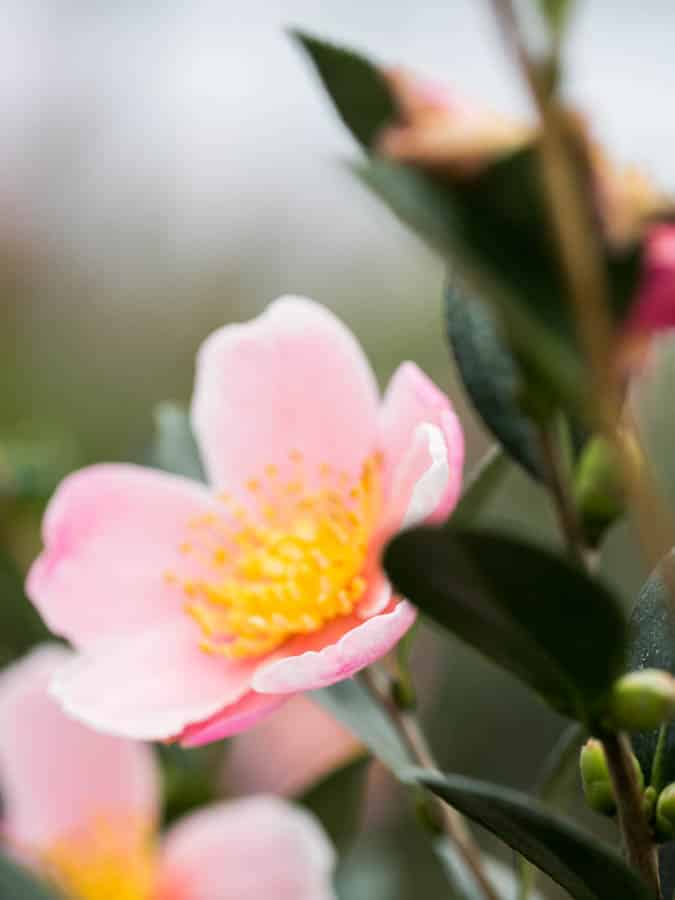
The most important thing about light is making sure the specific flower gets the right amount of light it needs. Lack of sunlight can cause a plant not to flower, and to stretch and become leggy as it reaches more for sunlight.
And for some plants, too much sun can burn their leaves, and cause over heating and even death.
Read this article for a list of full sun plants that bloom all summer.
Soil Type
Soil is an important part of growing flowers successfully. I can remember in my early twenties looking at the soil and thinking, weeds grow fine here, so flowers will do fine as well!
Needless to say it took me a few seasons to grow flowers successfully. It turns out you do really do need well draining nutrient dense soil for most flowers to grow.

The Basics Of Soil For Flower Gardening:
Soil structure refers to the make up of a specific soil: the way the silt, clay, and sand join together. Native soil can vary widely depending on the area in which you live.
The most important part of soil quality for growing flowers is to make sure it is well draining. This prevents roots from rotting and plant death.
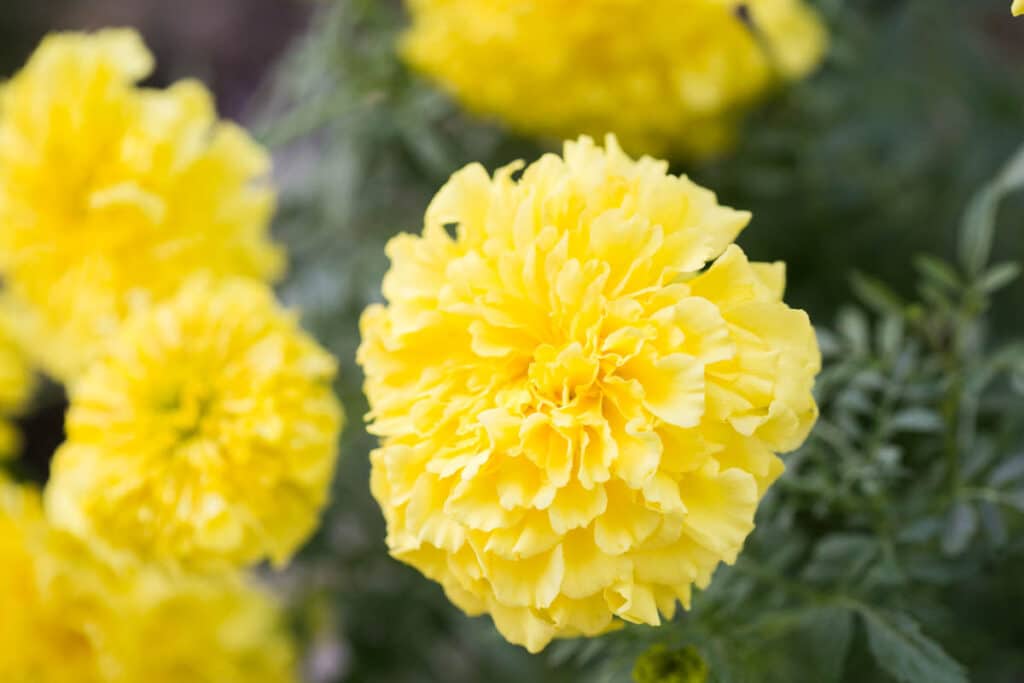
In general, flowers need loose, well draining soil in order to grow. Soil has different organic material within it, and there are different densities to soil.
Sandy soil drains well, while clay soil is denser and will hold water.
Some flowers need more nutrient dense soil in order to grow and thrive, and other flowers actually need soil with very little nutrients in it to bloom! (Cosmos and sunflowers come to mind).
Flowers need well-drained soil to thrive. Soil that retains water can cause the roots of the flowers to rot, resulting in dying plants!
When developing your flower garden beds, use nutrient dense, well draining soil. This soil will be a dark brown color and crumble in your hands, kind of like a moist cookie dough. Many flowers, herbs and flowering shrubs and trees will thrive in this healthy soil.
Keep in mind that if you do not want to alter your soil, you will have to grow with what you’ve got! Different plants are more tolerant of different kinds of soil, so do your research on each specific plant to make sure that you are meeting the plants’ needs with your native soil.
You can amend (make improvement to) heavy clay soil for better drainage. Add in mulch, compost or sand, and vermiculite. These soil amendments will help create a more porous soil allows for drainage.
A quick caveat: some flowers do grow well in poor soil conditions. Sunflowers and cosmos are two flowers that can grow in poor soil. Cosmos actually thrive in soil that is not very fertile! Before planting, research the specific growing conditions that your flower requires.

Learn how to get lavender to bloom here.
Watering A Flower Garden
The Basics: You will need an easy to access source of water for your flower garden. Since plants are unique in their water needs, some flowers will want the soil to dry out between watering, while others need a deep soak daily.
A consistent and reliable water source is crucial to watering your new flower garden, especially in very warm climates.
Instead of just watering the soil surface, it is more effective to water each plant deeply, giving it a good soak deep into the soil. This encourages the plant to develop a deeper root system. It’s always better to water less often but more deeply!
The best time to water is in the early morning, before the heat of the day.
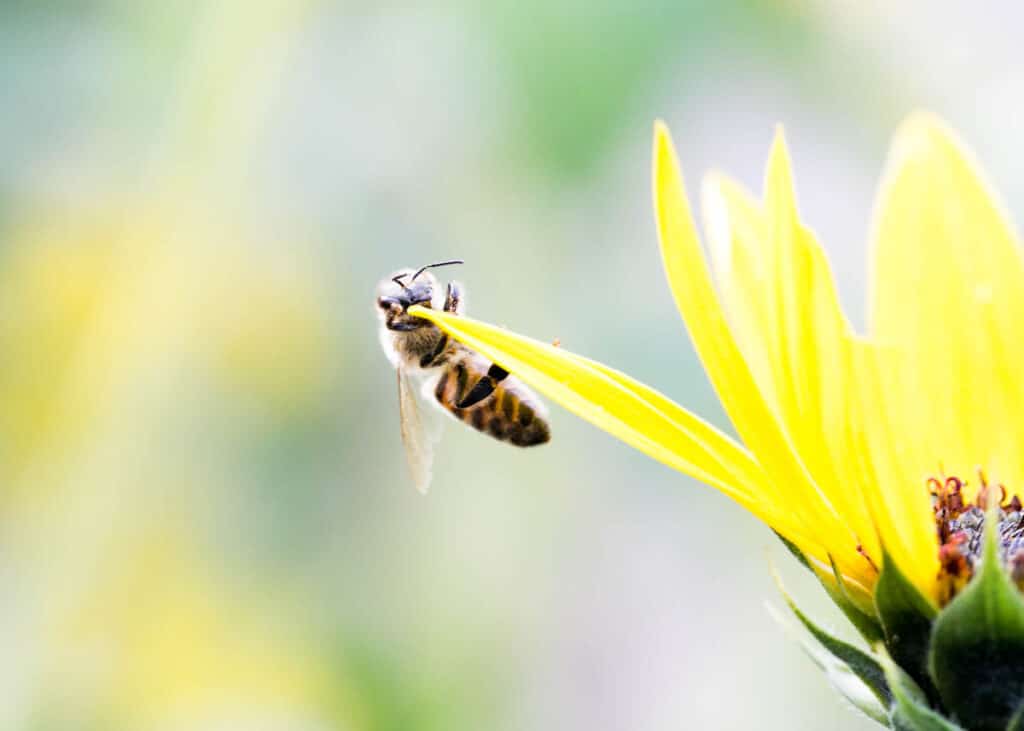
Use a hose attachment to create a gentle flow of water that won’t disturb the roots of young plants. And instead of watering on top of the flowers, make sure to water at the base of the plant whenever possible.
Water droplets that accumulate on top of flower leaves and left in the cool of the evening can turn into disease problems for the plant, such as fungus. So it is best to give the plant plenty of time to dry any excess water by watering during the day.
Most flowers appreciate the garden soil being left to dry out between watering. Keeping this in mind, you may not need to water every day, except during very hot weather.
Watering Flowers In Containers
Soil will dry out faster when growing flowers in pots and containers. You will need to monitor container raised flowers more closely and water more frequently, especially in hot weather.
Like with all of your plants, each flower is unique in it’s watering needs. Some flowering herbs, such as lavender, actually need very little water. Other plants, like hydrangea, crave a deep soak every day.
Getting to know your plants will help you to better meet their watering needs.
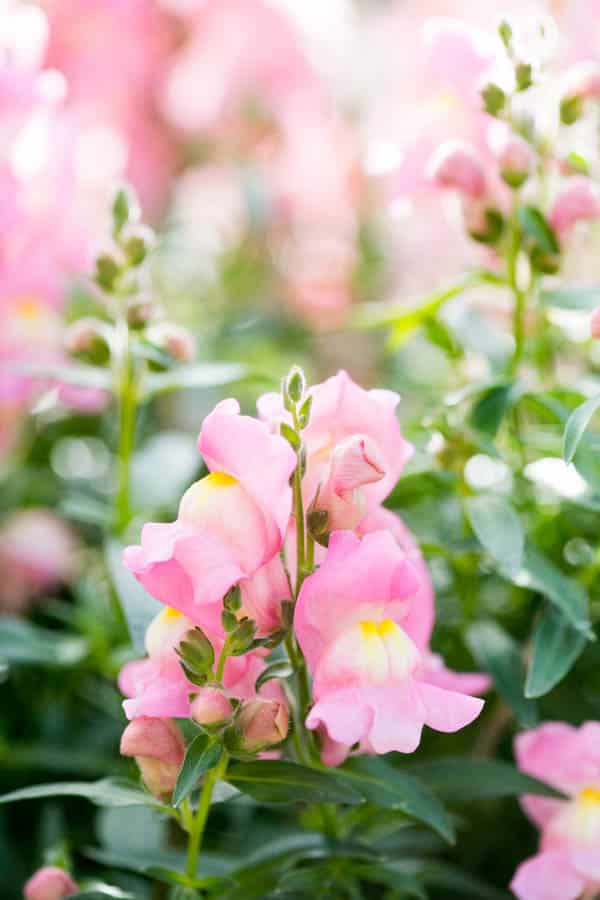
Pruning + Dead Heading Flowers
Keeping flower plants healthy and happy through dead heading is an regular task of the flower gardener.
For many plants, you will need to dead head them, or remove spent blooms, in order to encourage new blooms to form. This will encourage a longer blooming season and you’ll receive hundreds of beautiful blooms for your efforts!
Many flowers can be kept blooming all summer in this way. (Read our beautiful guide to dead heading dahlias right here!).
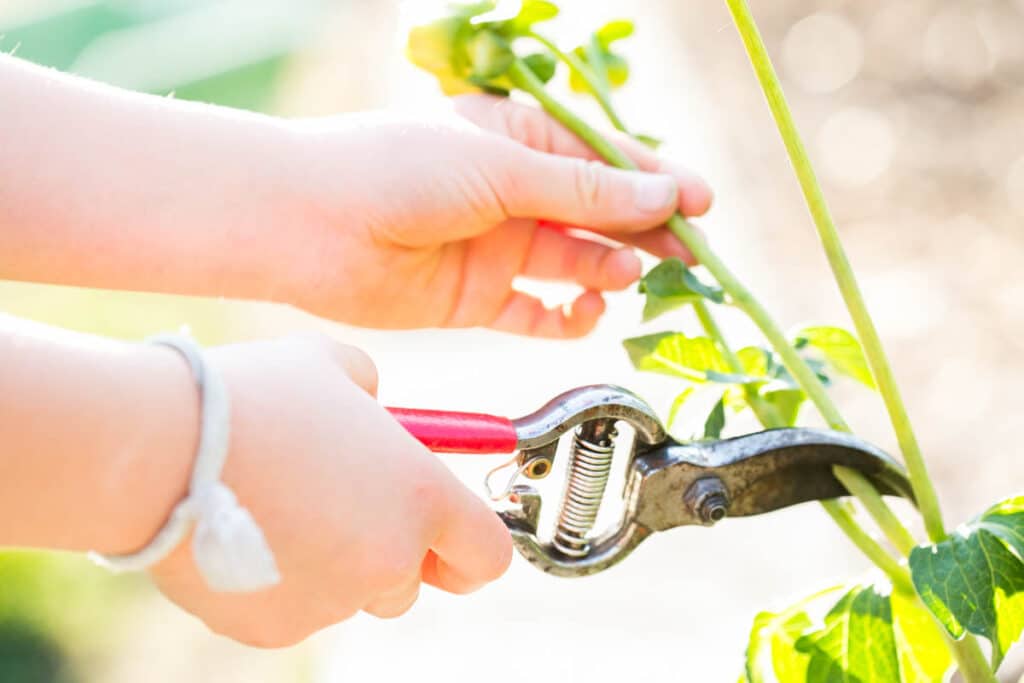
And some plants, like peonies, need to be pruned at the end of the season to promote plant health and prevent disease.
At times, you may also need to prune away or remove insect damaged or diseased leaves or flowers from your plant. Make dead heading your plants and checking their leaves over for health a regular part of your routine.
When pruning or dead heading, you can use a pair of small clean pruners, and with some plants you can simply pinch away spent blooms. Sanitize pruners in between plants to prevent disease.
While pruning may seem like a chore, dead heading flowers will often result in hundreds of gorgeous new blooms. Dead heading can often be done in just a few minutes every other day. It is well worth the time, effort and dedication!
Make Your Flower Garden Easily Accessible
In addition to studying your micro climate, make sure you choose a location that is easily accessible.
A good place to plant flowers is somewhere you will see them every day! This ensures you will be able to quickly water, dead head and weed your flower garden.
Out of sight is out of mind, and you want to make your flower garden easy to care for and in the fore front of your mind!
Choosing the right place for your flowers the first time will save time and effort later, so take your time in choosing a location that works for both you and your plants.
A note on location: It’s also nice to be able to enjoy a flower garden view from your windows if possible. A landscape of beautiful blooms and buzzing bees is a peaceful, calming view that should be enjoyed by all in the household!
Get our list of the best flowers for early spring here.

Flower Garden Design For Beginners
It can feel like a lot of work to design a flower garden for the first time, so we recommend you take it slow so you don’t get overwhelmed!
The most important aspect of designing a flower bed is to think about the size and dimension of the flowers you plan to use.
First, study the specific micro climate of the garden bed you are planting so you can have a firm grasp on what will grow in your area. Even a basic understanding of the light, soil and weather patterns will be a huge help as you plan.
The next step is to think about the style of flower garden you’d like to develop.
Height, width and color of plants should be taken into account.
You should also think about whether you’d like to regularly harvest your flowers. If so, be sure to add in cut flowers that work well in a vase, such as peonies, dahlias, cosmos and zinnias.
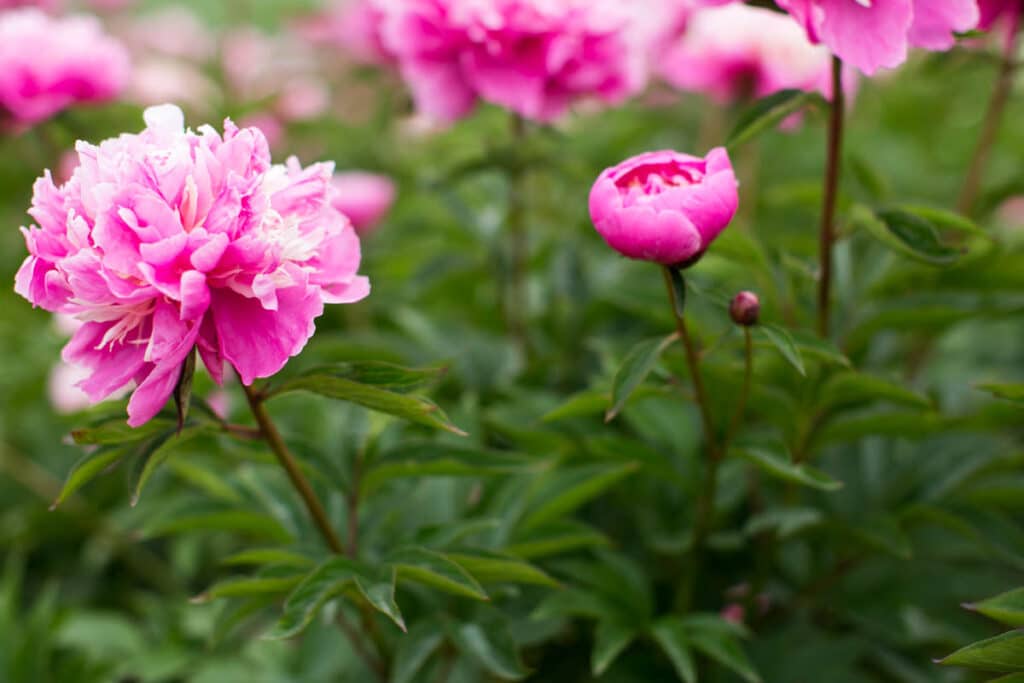
Beginner Flower Garden Design Tips
We know it can be overwhelming when starting from scratch and adding all new plants. Here are some beginner tips that will help:
- Use a garden calendar to plan a long blooming season. Some flowers bloom just in early spring, and others will flower generously until the last frost date.
- Know your end goals. Do you want a low maintenance flower garden? To attract hummingbirds? Or to have as many cut flowers as possible? Answering these questions will help you identify the flowers your should plant.
- Understand the specific needs of each plant you choose. (It’s ok to start slow and make sure the plant babies you purchase are thriving!).
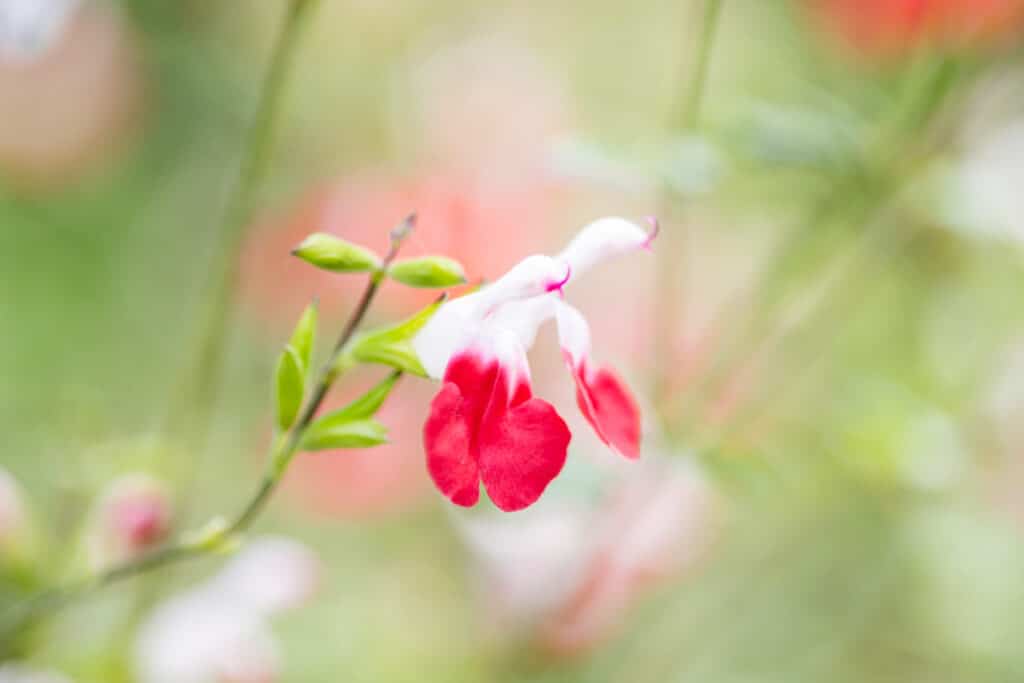
- Add variety of height: When planning garden bed design, consider the height of each plant. While height will add interest and dimension, make sure to position these plants so their shadows do not eventually over put other sun plants into shadow.
- Leave room for plants to grow: read about each plant to ensure proper spacing. Adequate air flow will prevent fungal disease in your plants such as powdery mildew.
- Accent your flower beds with taller plants and ornamental grasses. Adding decorative grasses will add texture and interest to your garden beds.
Spacing Out Your Flowers
A key component to designing a beautiful garden is making sure each plant has enough space to grow. Adequate space around each plant gives the flowers room for air flow and the roots plenty of room to spread out and find nutrients.
Proper spacing also prevents disease like powdery mildew from settling in on your flowers.
Spacing your plants away from the perimeter of your home is also important. You should set the base of the plant at least two feet away from the foundation of the house, and even further for larger shrubs.

Planning A Cutting Garden
Many gardeners choose to intermix their specific flowers grown for cutting, such as zinnias or snapdragons, into their flower beds. But some long for more: rows and rows of flowers blooming all summer just ripe for the cutting.
Planning a flower bed or two specifically for cut flowers is nothing short of exhilarating! The thought of fresh cut flowers on the summer table leaves us swooning. I digress…

To plant a cut flower garden, designate a specific area just for your cut flowers. This can be a raised bed, section of the garden, or side flower bed. Research your flower and alter the soil for your specific plant, if needed. Follow the instructions on the side of the seed packet for your specific flower spacing and sow your seeds.
A specific cut flower garden will often feature annuals like cosmos, zinnias, snapdragons (which may bloom for two seasons), sunflowers, or flowering bulbs such as tulips or daffodils.
Read our in depth guide to cut flower gardens here.
No Space For A Flower Garden?
If you are hoping to start a flower garden but don’t have a lot of space, consider these options:
- Front Yard: Consider turning your front yard into a flower garden! Remove some of the grass and add flower beds, bark chips and rock to design a beautiful flower garden in your front yard! Your neighbors and local pollinators will both be swooning.
- Back Porch: A back porch or patio can be a welcome spot for a small flower garden. Colorful container gardens on the back porch featuring snapdragons, nasturtium, petunias and dwarf zinnias do well. A major benefit of growing flowers off the patio is they are easy to access, which makes watering and dead heading a breeze! Container gardening is a great way to add color and beauty to your life without a lot of effort. Just make sure your containers have drainage holes, and water more frequently.
- Side Yard: If there is plenty of light and good soil, a small space such as a side yard can support a surprising amount of flowers. Consider turning that un-used side yard into a small bed of beautiful flowers. Add a raised bed or till up the soil and plant zinnias, cosmos and sunflowers. The bees and butterflies will be there in no time, and you can get a surprising amount of bouquets from a small flower patch!
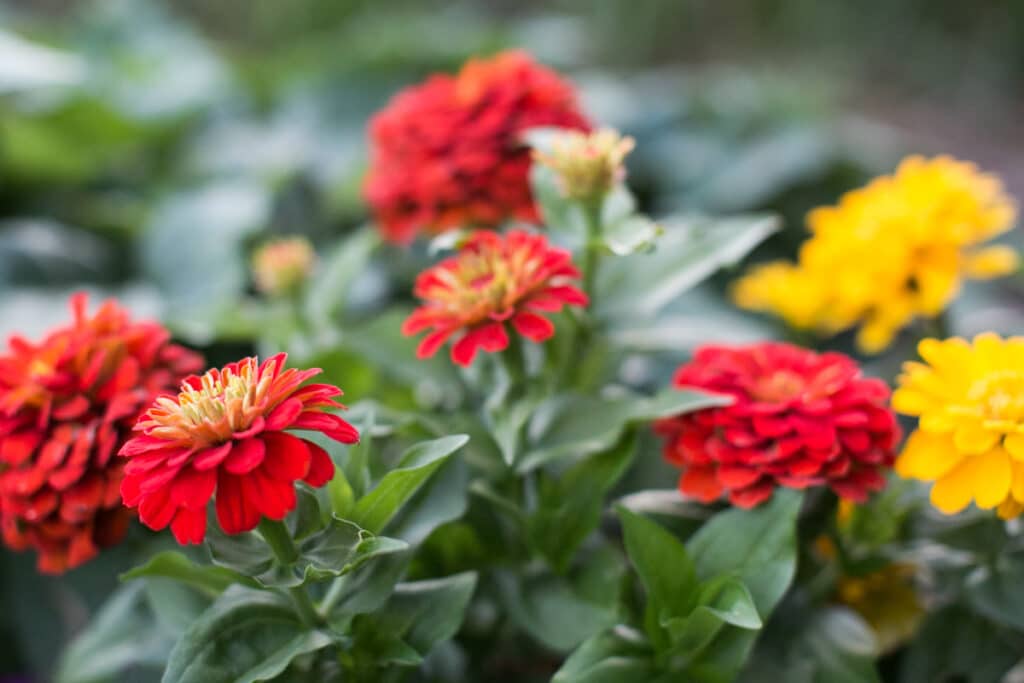
Overwhelmed As A Beginner Flower Gardener?
Overwhelmed by choosing the right flowers for your garden beds? We’ve been there!
The best thing to do when overwhelmed is to choose just a few plants that you know you like and focus on making them happy. Doing this will give you experience with soil and light that you can apply to other plants!
I love big, classic blooms so for several years I focused on peonies, learning everything I could on how to grow and enjoy them as cut flowers. I studied why ants are often on peonies, different colors of peonies, and how to care for them after they bloomed.
Of course, I supplemented my peony education by growing a few annuals in containers, like petunias, zinnias and nasturtiums.
Taking a few plants at a time and learning about them can be the key to success in the garden. It’s okay to revel in being a beginner flower gardener… use this time to grow in your knowledge.
Grow slowly if you need to, choosing a few plants to study and learn about. Add more to your skill set as your are able.
We made this ultimate guide for beginner flower gardeners into a book that you can print for easy reference. Get it here!
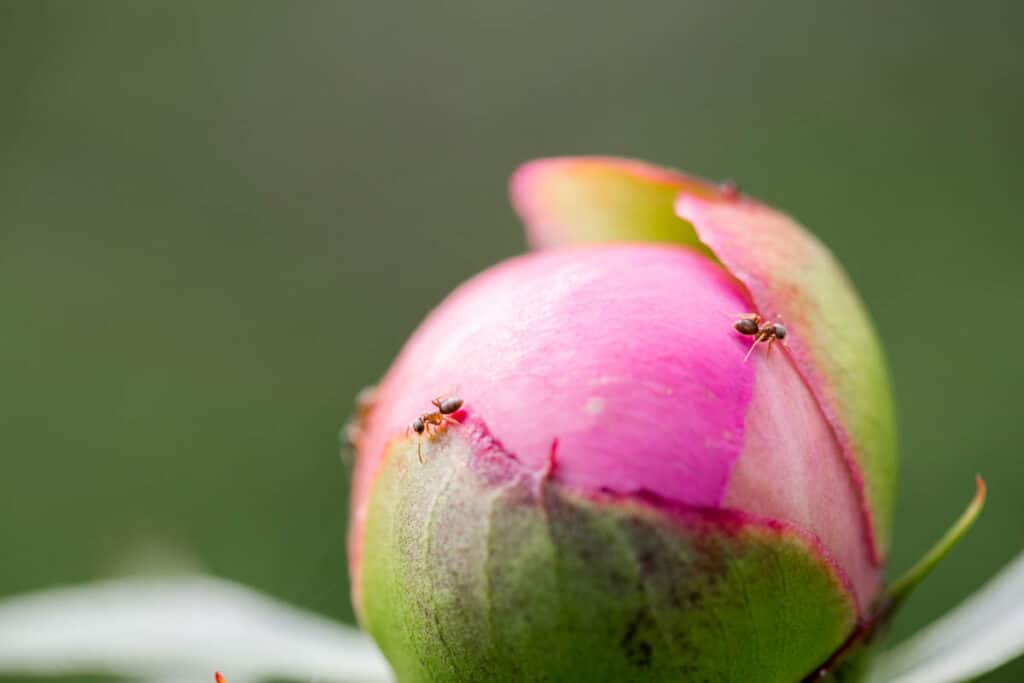
The Easiest Flowers To Grow For Beginners
When designing a beautiful flower garden for the first time, it can be really helpful to focus on the easiest flowers! Quick flower wins will grow your confidence as a beginner flower gardener.
Here is a list of nine easy to grow flowers for your first foray into flower gardening. These plants are known to be easy to grow and hardy:
Pansies
Pansies are an early spring flower that are very easy to grow. They come in many colors and do well in different light conditions. Pansies are an easy way to get a jump start on your flower gardening in the spring.
Snapdragons
Snapdragons love cool temperatures and are very charming. They show up in early spring, flowering at the base of the plant first. Then, they reappear with new flowers as a late bloomer in fall. Read more about growing them in pots here.
Cosmos
Cosmos are beautiful annuals with ferny foliage and beautiful ruffled blooms loaded with color. These bright cutting flowers come both in dwarf varieties and tall plants. These annuals are very low maintenance and make great cut flowers.
Zinnias
Zinnias are easy to grow from seed and bloom all summer long. They come in many different colors, shapes and heights! Zinnias are truly one of the easiest flowers to grow- just ask my kiddos, we’ve grown them together since they were toddlers! Try mini zinnias in containers.
Nasturtium
Edible, jewel toned nasturtium are one of our favorite flowers. Brighten up a salad with their bright colors and peppery taste, and enjoy their bountiful cascading flowers in containers and window boxes. Nasturtiums make flower gardening enjoyable, edible and easy!
Sunflowers
Sunflowers come in many varieties and colors and are one of the easiest flowers to grow. They are a gardener’s classic and hold great sentimental value. We love growing dwarf sunflowers and using them for cut flowers. Plant in full sun, from seed, and enjoy!
Established Dahlias (purchased in containers)
Dahlias are quick growing, and you can literally get hundreds of dahlias from one plant. Purchase a healthy dahlia plant from a gardening center and plant it after frost has passed. Dahlias are the best choice for a long blooming flower. Grow them in fertile, well draining soil in full sun.
Read our complete guide to growing dahlias here!
Catmint
Camint was one of the first plants we ever fell in love with. With flowing, romantic purple stalks and sage green leaves, this bloomer works well in cottage styled gardens. Catmint enjoys full sun and well draining soil. This flowering herb is very hardy and easy to grow.
Peonies
Peonies were one of the first perennial flowers my husband and I planted together. These luscious flowers bloom in mid to early spring. Peonies are impressive- they bring large, beautiful blooms to the garden. Though they look intimidating, you simply plants their roots in loose, well draining soil in the spring.
These are just a few easy flowers to grow… there are many more! Remember to take in your specific gardening zone and micro climate into account!
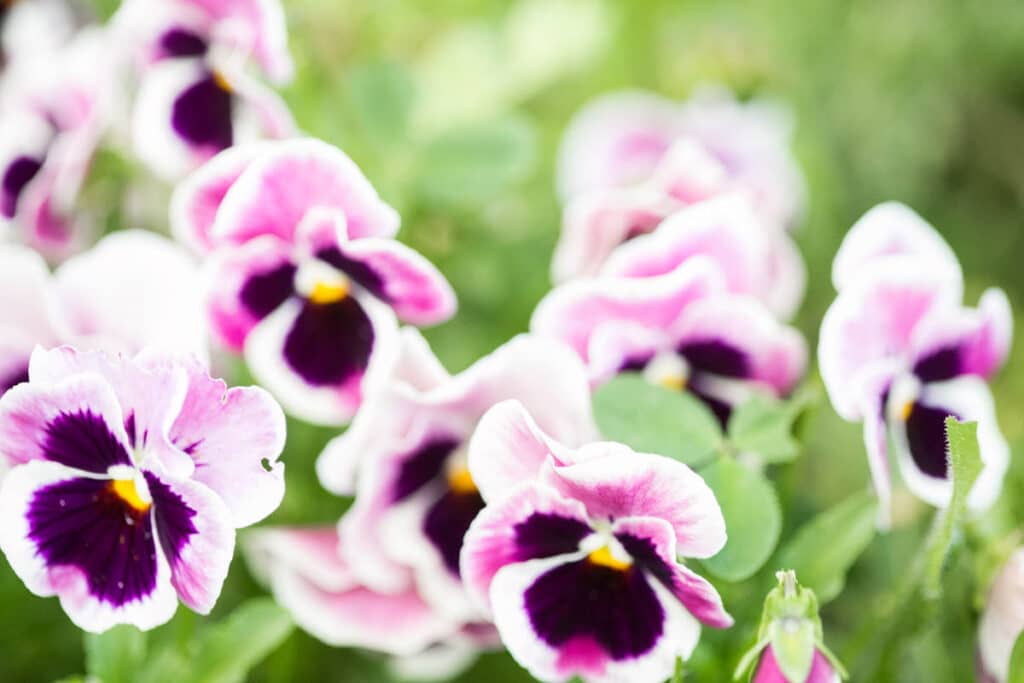
Get the best list of gorgeous annuals for full sun here.
Starting Plants From Seed
Many beginner flower gardeners purchase starts, or plants that are a few inches tall, from a reputable gardening center.
But if you want to get a head start on your flowers you can consider growing flowers from seeds and then planting the starts in late spring.
Some flower seeds can also be sown directly into the soil after all danger of frost has passed. Sunflowers, cosmos, and zinnias do very well planted by seed in late spring/ early summer.

These plants will bloom well into fall, so even though they take a few months to start flowering, you still have plenty of time to enjoy them as mid summer through late autumn flowers.
You can also dip your hand into growing flowers from seed inside, and then transplanting the seedlings. You will need room to set up your growing station, soil, a light source, and seed starting trays.
Some flowers that are easy to start indoors are: nasturtiums, calendula, poppies and sunflowers.
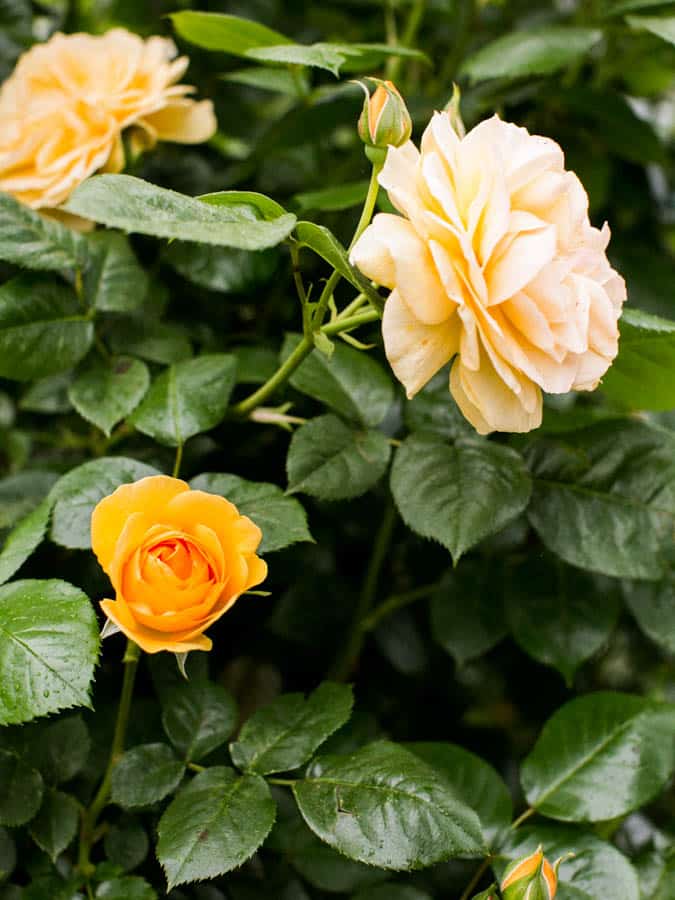
Be inspired with these beautiful flower quotes.
In Closing: Flower Gardening Is An Experience!
As you build your own flower garden, we’d like to leave you with permission to just enjoy the process of flower gardening. As you put in the hard work, don’t forget to stop and smell the roses… literally!
Put aside your notions of a perfect flower garden and just enjoy the experience! While flower gardening is extremely rewarding and relaxing, it can also stress us out if we try to get it “just right”.
Remember that planting flowers is both a science and an art… and mistakes will made no matter who the gardener is! The best teacher truly is experience.
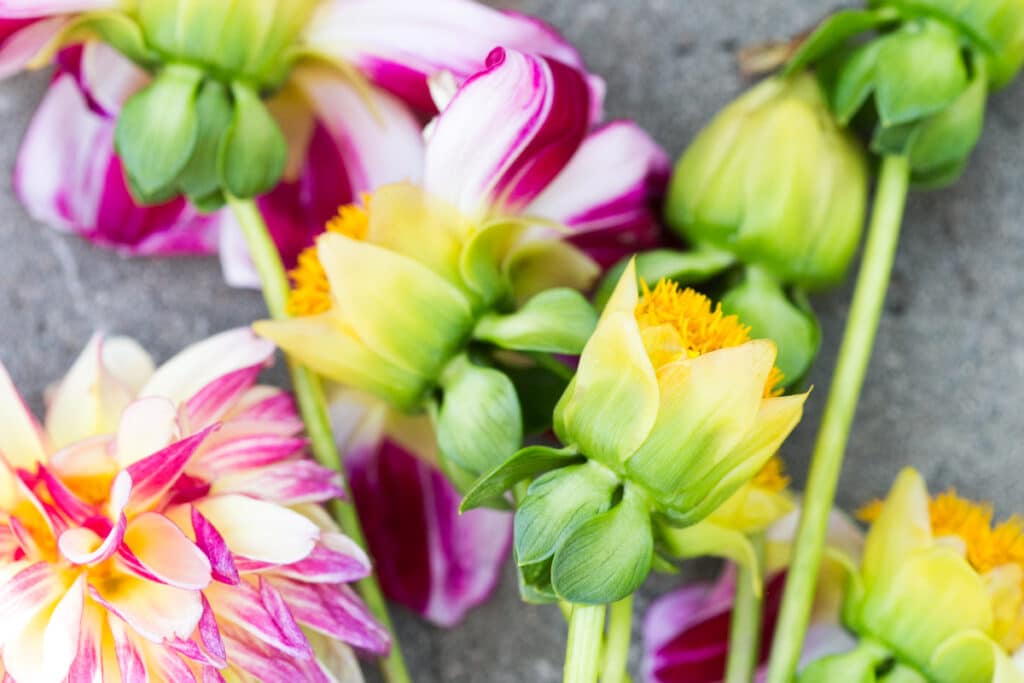
When designing your own garden realize mistakes will come… but they will also go. Gardening is very forgiving, and you can always move plants if need be, or even start over! Most gardeners go through a period of trial and error.
One of the most important things is to just have fun and enjoy the process. To design a generously blooming flower garden is no easy task, so remember to go slow and dedicate yourself to becoming a student of the blooms.
Allow yourself to fall in love with flowers that fit your lifestyle and tastes!
Make your dream flower garden the one you have right now, with a gentle and forgiving approach to the beginner flower gardening experience!
“I like gardening—it’s a place where I find myself when I need to lose myself.” -Alice Sebold
We hope you found this beginner’s guide to flower gardening inspiring and useful. Let us know in the comments below how your flower garden is growing! With love, Jamie
P.S. Interesting in growing flowers indoors? Read about them here and here.

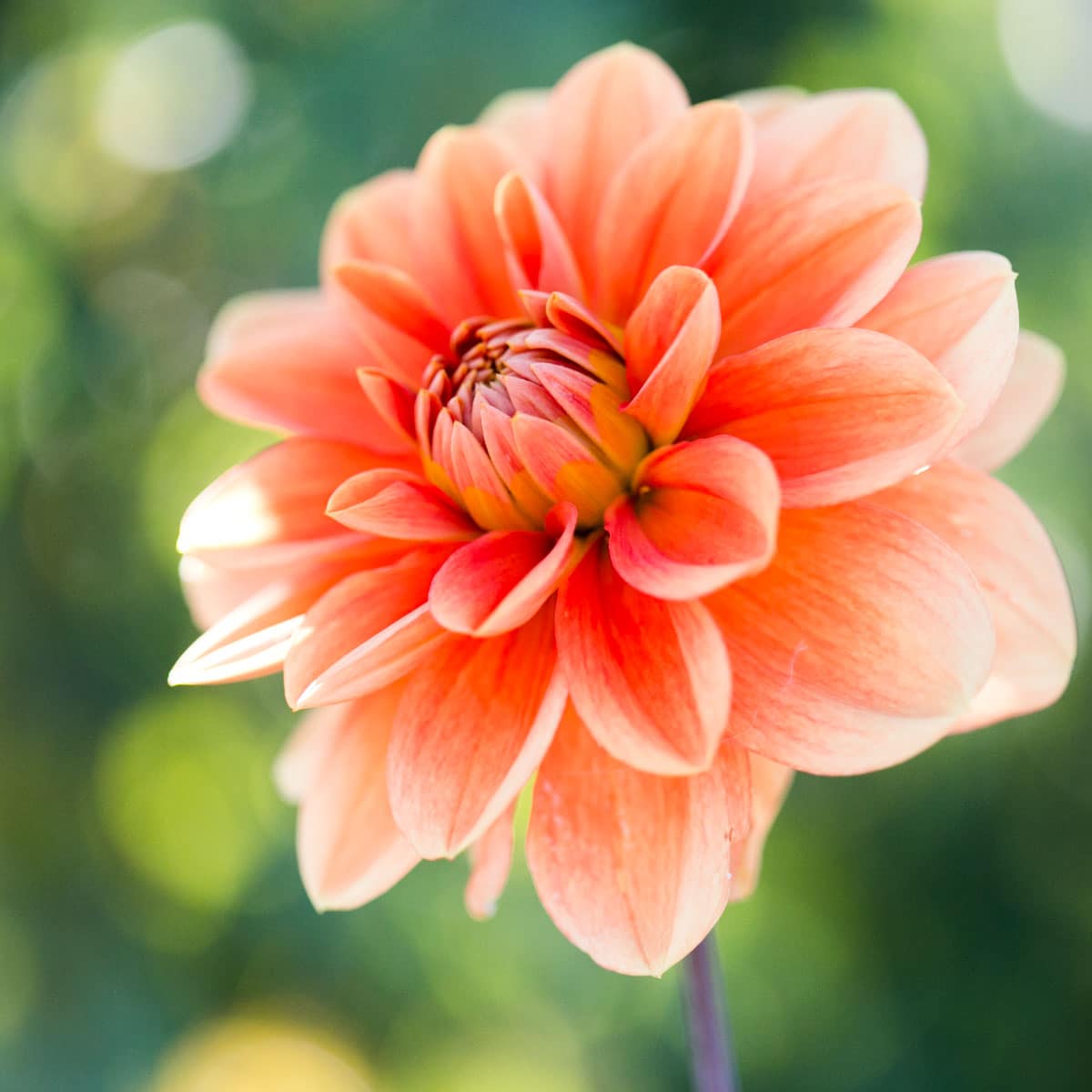
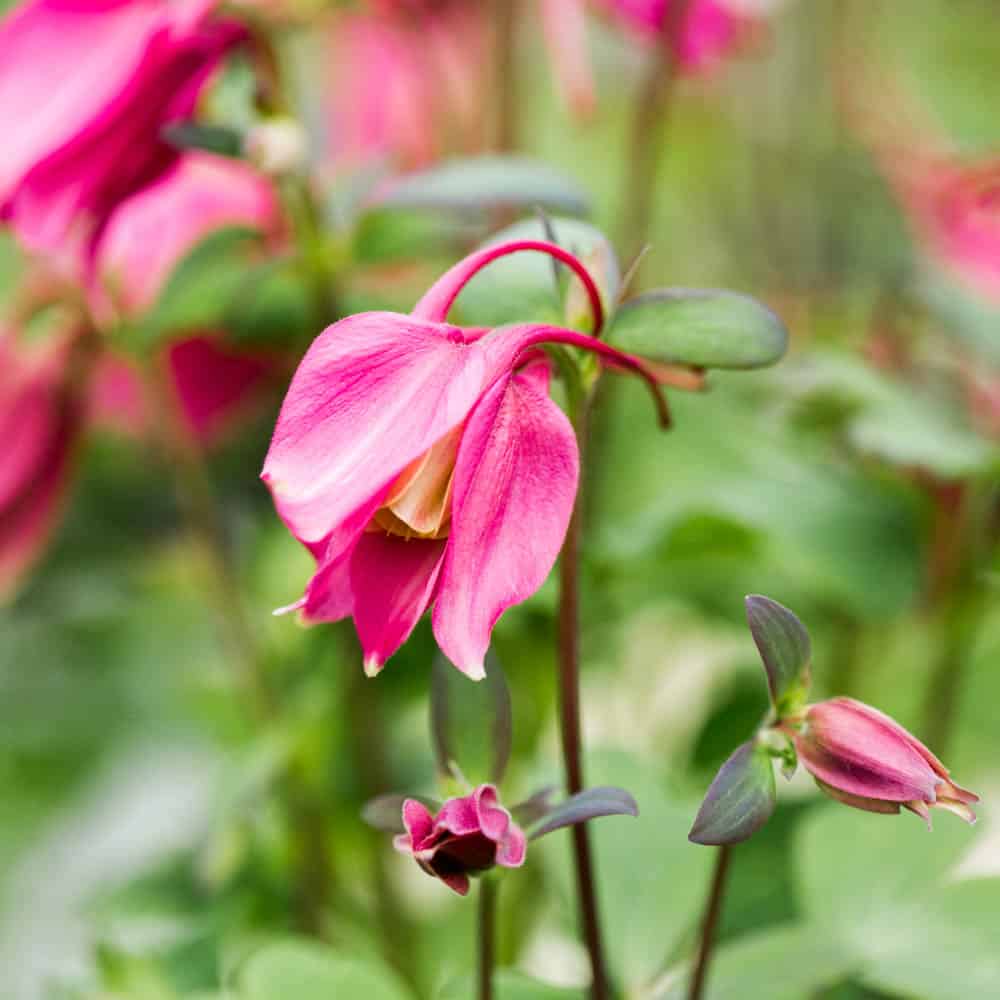
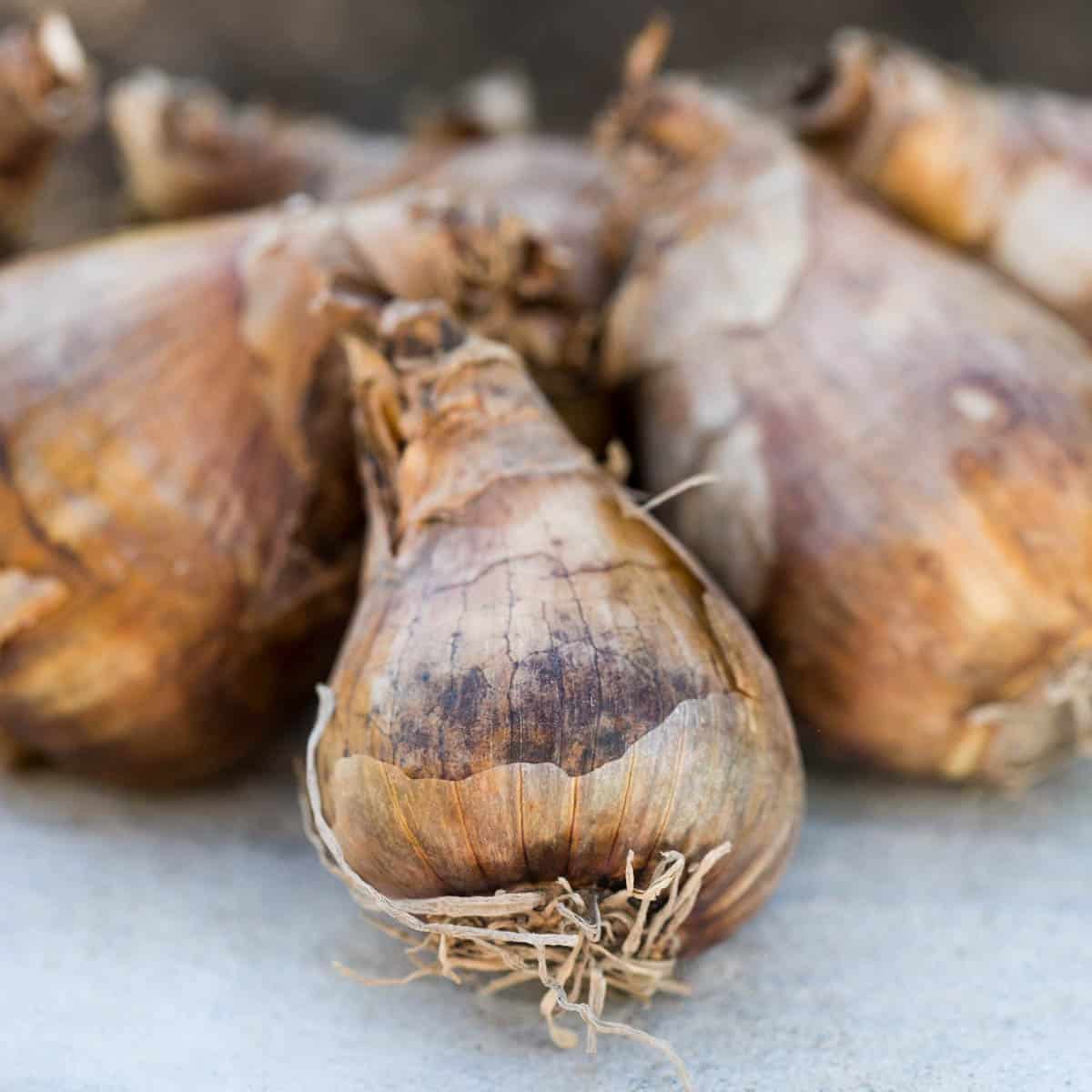
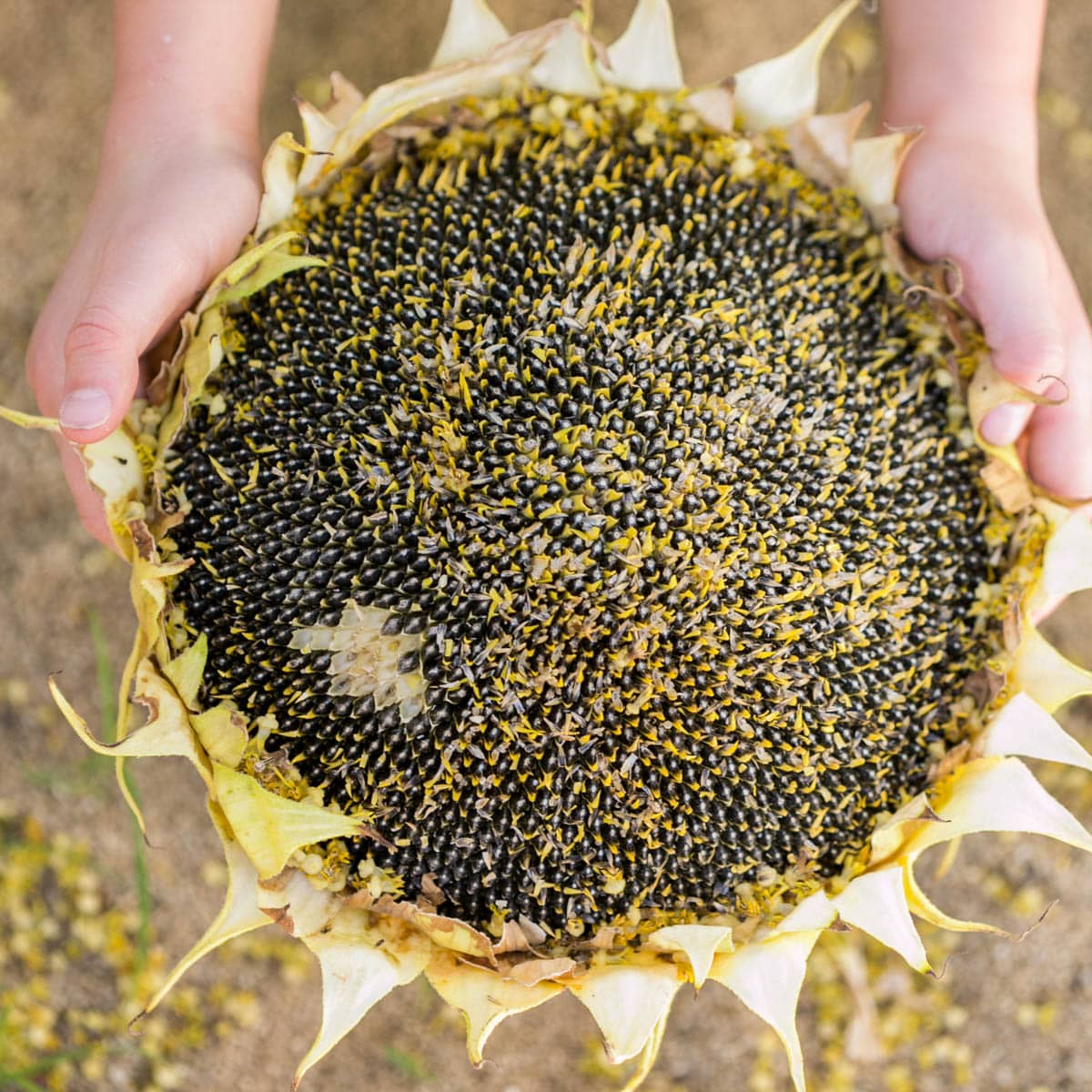
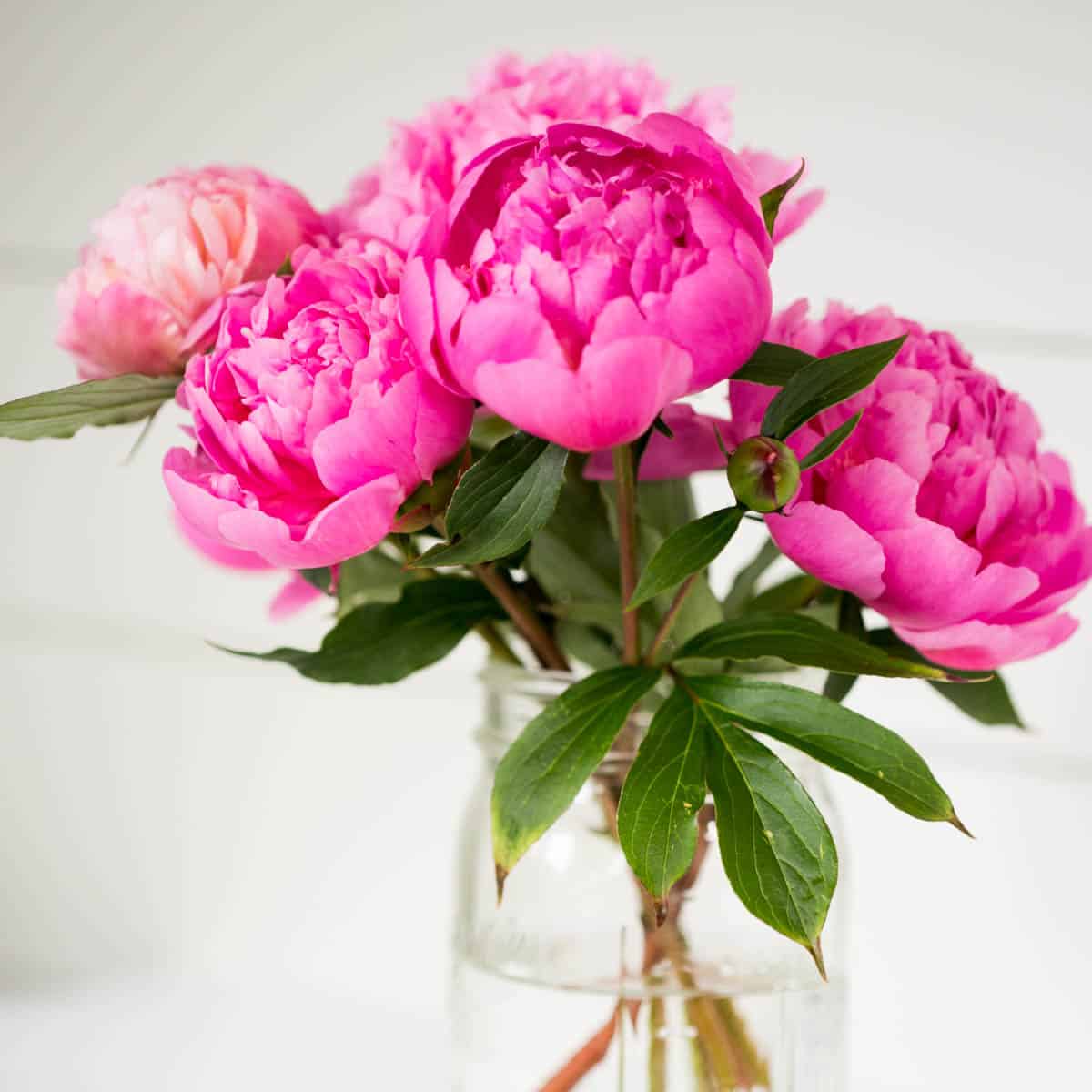

Thanks for this beginners guide! My goal is to plant a flower garden of some sort this year so this was very encouraging and helpful.
Excellent and inspiring information.